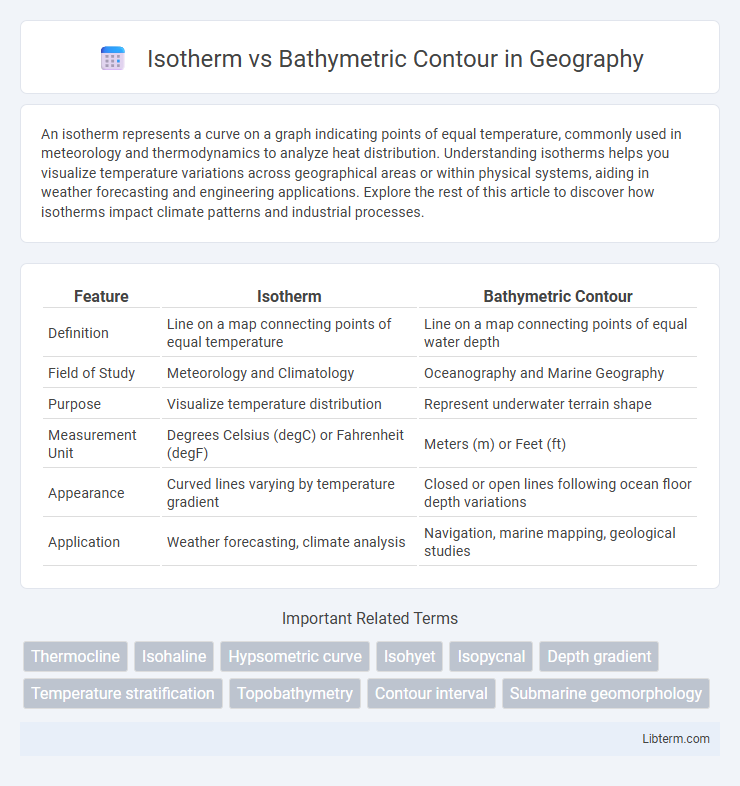An isotherm represents a curve on a graph indicating points of equal temperature, commonly used in meteorology and thermodynamics to analyze heat distribution. Understanding isotherms helps you visualize temperature variations across geographical areas or within physical systems, aiding in weather forecasting and engineering applications. Explore the rest of this article to discover how isotherms impact climate patterns and industrial processes.
Table of Comparison
| Feature | Isotherm | Bathymetric Contour |
|---|---|---|
| Definition | Line on a map connecting points of equal temperature | Line on a map connecting points of equal water depth |
| Field of Study | Meteorology and Climatology | Oceanography and Marine Geography |
| Purpose | Visualize temperature distribution | Represent underwater terrain shape |
| Measurement Unit | Degrees Celsius (degC) or Fahrenheit (degF) | Meters (m) or Feet (ft) |
| Appearance | Curved lines varying by temperature gradient | Closed or open lines following ocean floor depth variations |
| Application | Weather forecasting, climate analysis | Navigation, marine mapping, geological studies |
Introduction to Isotherms and Bathymetric Contours
Isotherms are lines on a map that connect points of equal temperature, providing valuable insights into temperature distribution across geographical areas. Bathymetric contours, on the other hand, represent lines of equal depth below the water surface, used to map underwater terrain such as ocean floors and lake beds. Both isotherms and bathymetric contours serve as essential tools in environmental and marine studies, facilitating the visualization of temperature patterns and underwater topography, respectively.
Defining Isotherms: Temperature Mapping Explained
Isotherms are lines on a map connecting points of equal temperature, enabling precise visualization of temperature distribution across geographic areas. These temperature contours play a vital role in meteorology and climatology by illustrating thermal gradients and patterns on weather maps. Unlike bathymetric contours that depict underwater topography, isotherms specifically map atmospheric or surface temperature variations for environmental analysis.
Understanding Bathymetric Contours: Mapping Ocean Depths
Bathymetric contours are lines on a map that connect points of equal ocean depth, providing a detailed representation of the underwater terrain. These contours enable the visualization of seabed features such as underwater mountains, trenches, and slopes, essential for navigation, marine research, and habitat mapping. Understanding bathymetric contours allows scientists and oceanographers to analyze the shape and structure of the ocean floor, facilitating studies in marine geology and hydrography.
Key Differences Between Isotherms and Bathymetric Contours
Isotherms are lines on a map connecting points of equal temperature, providing insight into thermal distribution in the atmosphere or ocean. Bathymetric contours represent lines connecting points of equal depth underwater, illustrating the topography of the ocean floor or lake beds. While isotherms help analyze temperature variations and climate patterns, bathymetric contours are crucial for understanding underwater landscape features and navigation safety.
Scientific Applications of Isotherms
Isotherms are crucial in scientific applications for mapping temperature distribution within ocean waters, providing essential data for climate studies, marine ecology, and ocean circulation models. Unlike bathymetric contours that delineate underwater topography, isotherms help identify thermal layers and thermoclines, which influence marine species habitats and nutrient transport. Their use in monitoring temperature gradients supports predictions of weather patterns and assessments of climate change impacts on marine ecosystems.
Uses of Bathymetric Contours in Marine Navigation
Bathymetric contours represent underwater topography by connecting points of equal depth, crucial for safe marine navigation by identifying hazards such as submerged rocks, reefs, and sudden depth changes. Mariners rely on bathymetric charts to plot courses that avoid underwater obstacles and ensure vessel stability, especially in shallow or complex coastal areas. These contours also assist in planning anchorages and optimizing routes for fishing, dredging, and submarine cable laying activities.
Isotherm and Bathymetric Contour Visualization Tools
Isotherm visualization tools map temperature gradients within bodies of water or atmospheric layers, using color-coded lines to indicate equal temperatures, essential for climate studies and oceanography. Bathymetric contour tools display underwater topography by connecting points of equal depth, aiding maritime navigation, habitat mapping, and geological analysis. Advanced GIS software and specialized platforms like ArcGIS and QGIS integrate both isotherm and bathymetric contour visualizations for comprehensive environmental modeling and spatial analysis.
Data Collection Techniques for Isotherms and Bathymetric Contours
Isotherms are mapped using temperature data collected through methods such as satellite remote sensing, oceanographic buoys, and CTD (Conductivity, Temperature, Depth) sensors deployed on research vessels, which provide precise vertical temperature profiles. Bathymetric contours rely on sonar-based techniques like multi-beam echo sounders and single-beam sonar systems that emit sound waves to measure water depth, combined with GPS for accurate geographical positioning. Both data collection approaches require extensive data processing and interpolation to create continuous contour maps representing temperature gradients or seafloor topography.
Isotherms vs Bathymetric Contours: Interpretation Challenges
Isotherms and bathymetric contours both represent lines on maps, but they depict different physical phenomena--temperature variations for isotherms and underwater depth for bathymetric contours. Interpretation challenges arise because isotherms reflect dynamic atmospheric or oceanographic temperature changes, influenced by seasonal cycles and currents, while bathymetric contours are static representations of seafloor topography, requiring different analytical approaches. Distinguishing between temporal temperature gradients and fixed underwater features demands carefully contextualized data analysis to avoid misinterpretation in geoscience and oceanography.
Conclusion: Choosing the Right Contour for Your Analysis
Selecting between isotherm and bathymetric contours depends on the specific environmental variable and analysis objective. Isotherm contours, representing temperature gradients, are ideal for thermal studies and climate modeling, while bathymetric contours map underwater topography, crucial for marine navigation and habitat mapping. Understanding the data context and analysis goals ensures the optimal contour choice for accurate and meaningful results.
Isotherm Infographic

 libterm.com
libterm.com